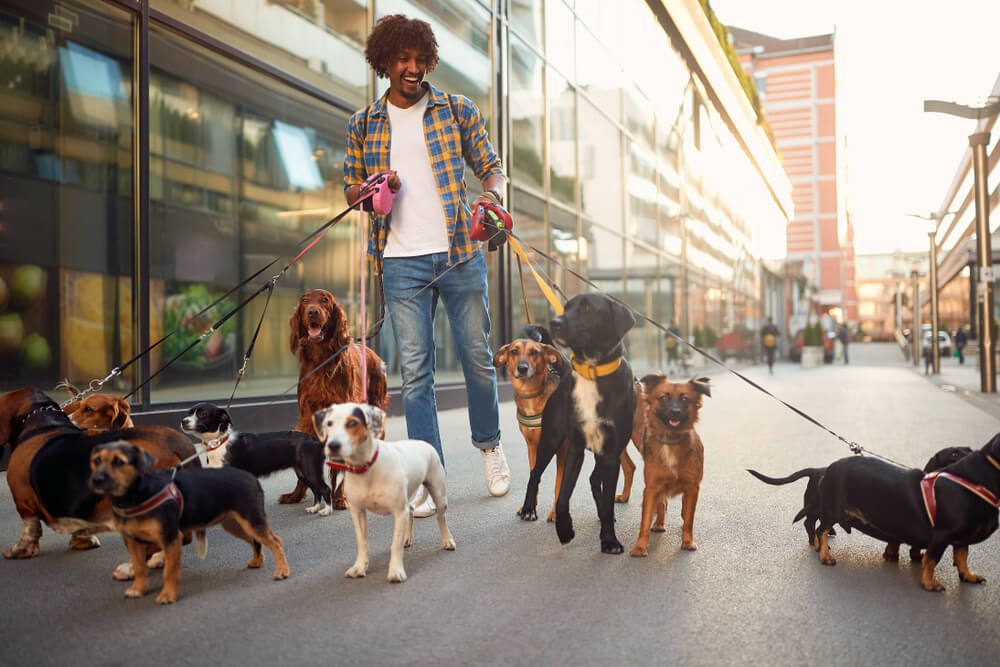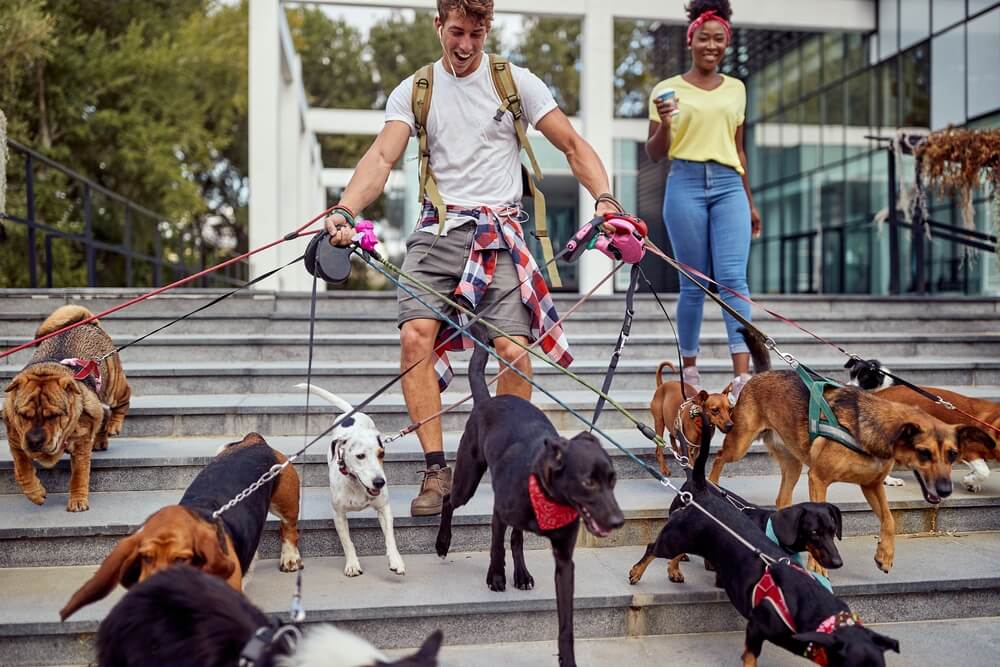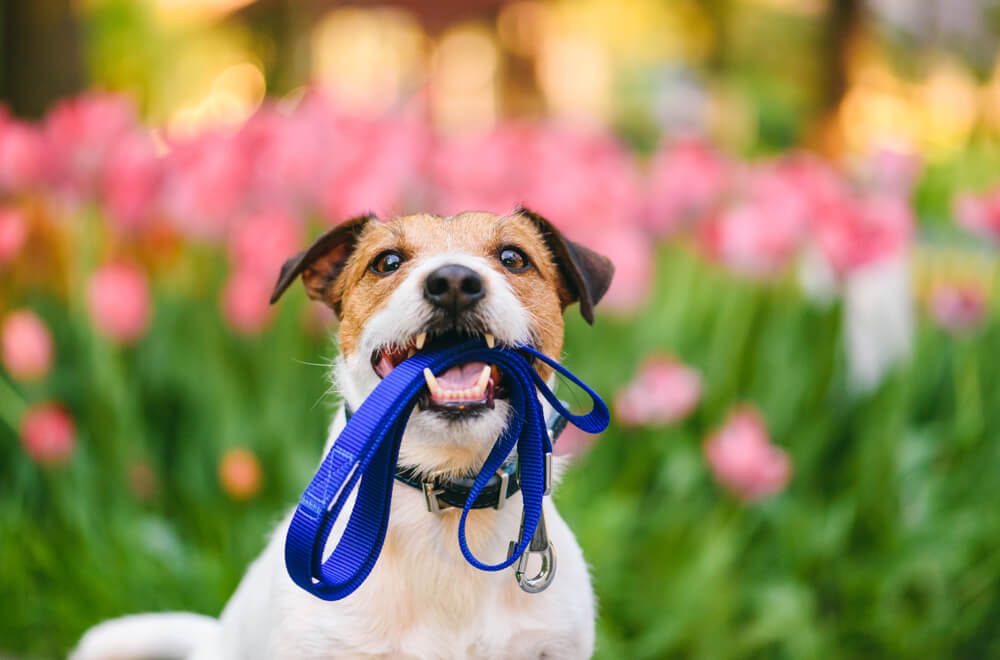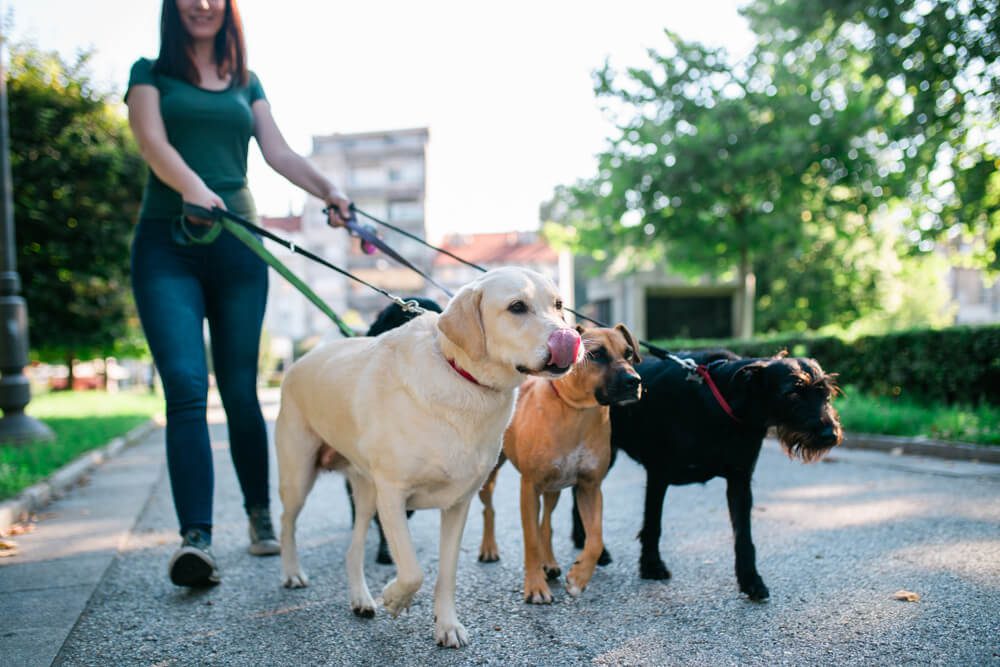How to Become a Dog Walker

Table of Contents
How to Become a Dog Walker
What Does a Dog Walker Do?
Dog walkers are involved with pet care by walking dogs for dog owners who are away from home or do not have the time to exercise their own dogs.
Many dog lovers who embark on dog walking as a career or side hustle will exercise a few dogs at once. Their responsibilities will be to clean up after their furry friends, select walking routes that are pet friendly, and tend to any of the dog care needs that arise when the dogs are with them.
Even if a dog walker’s attention is divided amongst several pets, dog walkers need to have the ability to manage and focus so that each pet receives quality supervision, and engagement.
Some dog walkers run their own businesses that offer other pet-related services. Another option is to register and work with a dog care company.
Dog Walker Requirements
Below we will list some things to consider if you would like to offer dog walking services:
Soft Skills
When it comes to soft skills and interests, you want to first and foremost be a dog lover. This role will suit someone who knows, understands, and bonds with pets.
Attention to detail and a level-headed demeanor are also advantageous. Sometimes clients’ dogs can be overwhelming, and you need to be able to calmly problem solve.
Having a dog walker job also demands a lot of energy. You should be fit and energetic, with a love for the outdoors, no matter the weather. Sometimes you’ll need to walk dogs in rainy and cold weather or scorching hot days, so having a cheerful attitude and dedication to your job will help.
A dog walker needs to be comfortable with “all things dogs.” This includes feeding them, cleaning them off if they ran into a muddy puddle, and knowing how to pick up and dispose of dog droppings properly. Understanding how various leashes and restraints work can ease frustrations when wrestling with retractable leashes that operate differently.
Training
You can grow your business and gain credibility by furthering your dog education and training. However, training is not essential. As a full-time or part-time dog walker, potential clients like to know that you’ve embarked on some training that gives you authority with pets.
- Depending on where you live, a driver’s license, access to pet-friendly transport, and regional permits for the use of local parks are required to get around your city easily.
- Typically a high school diploma or GED can be beneficial if you want to do courses or gain certification for your job.
- Understanding typical traits for various breeds can also work in your favor. You can read up on your new client’s dog breed before taking on a fresh role.
- Become knowledgeable about unique needs that your client’s pet may need. Understanding how to help an old or fragile dog can boost your clientele and make you the go-to person for senior dog walking.
- Courses in pet grooming, dog nutrition, body language, disease prevention, or general animal behavior can boost your referrals and small business status. Many dog organizations or online correspondence courses offer these tools.
Certifications
A professional dog walker will have certifications that enrich their knowledge and help them land new clients. Below are a few certifications that could put you a step ahead of your competitors:
- Animal Training Certifications
- Certified Professional Pet Sitter (CPPS)
- National Association of Professional Pet Sitters (NAPPS) certification
- CPR and Pet First Aid Certification
Legal Requirements
Some states may require that you have a Commercial Dog Walking Permit Application. (Click here to see an example of the permit application for Massachusetts.)
In New York, a small animal boarding establishment permit should be attained by any animal care business. The permit is for any service where animals are not owned by the person sheltering, maintaining, or caring for the animal. The Department of Health and Mental Hygiene (DOHMH) issues this specific permit.
Your state may also have leash and dog waste collection laws.
While pet vaccinations concern pet parents, having clarity about the client’s dog’s health is important. For example, if a rabies quarantine order has been issued for a pet, a dog is not allowed to leave its owner’s premises unless “under leash or the control of a responsible person.” It’s essential to become familiar with animal laws in your area.
Bottom line: Call your city or county code office to check your local laws and requirements. They can also let you know if you need a business license.
Insurance
Protect yourself and your business by investigating insurance options.
Dog Walking Insurance
Dog walking insurance can cover you in the event of accidents, injuries, loss, legal fees, or damaged vehicles (an anxious pet may chew up your car seatbelt).
While you cannot predict unfortunate events while walking dogs, you can prepare for them. Insurance can help pay for veterinarian care and medical care for yourself or other people and pets who may have been involved in a fight in the park.
Dog walking insurance costs vary based on your business risks, such as:
- Pet services types that you offer
- Location of your clients
- If you have any employees
- The type of vehicles you use for work
Business Insurance
Business insurance is essential to run a dog walking service with employees. Business insurance typically covers injury for yourself and employees, lost wages, vehicle accidents, business errors, defense costs, or property damage.
You can select various coverage for your business insurance package: general liability insurance, product liability insurance, workers’ compensation insurance, and more. No matter the size of your business, speak to a broker to decide what you need now and in the future should your business grow.
Business insurance costs vary based on your business risks, experience, number of employees, and coverage options.
Tip: Dog walking services offer insurance. If you choose to sign up with one, ask them what protection they offer for various scenarios.
Gear
A few essentials in your backpack can prepare you for drama while on the job. Pet owners might provide some things (like their dog boots), but having backup gear ensures that you always have the essentials.
Listed below are some dog walking items that will give you and your pet parents peace of mind for any event:
- Pet first aid kit: Know how to remove a tick, administer medication (with approval from the pet owner), deal with exposure to toxins, or injury triage.
- Poop bags
- Portable water bowls and water
- A waist walker or hands-free leash: These harnesses attach to a dog walker’s waist and allow them to connect multiple leashes.
- Fanny packs: Easily reach for dog treats when you need to reward good behavior.
- Pet deterrent spray or mace: Protect yourself and your client’s dogs from hostile humans or stray dogs.
- A reflective vest or headlamp: This is helpful if you tend to work at night or in the early hours.
- Appropriate clothing: Comfortable shoes, activewear, windbreaker or raincoat, etc., depending on the season.
- Sunscreen for yourself and the pets.
- A lightweight phone power bank: The last thing you want is a dying battery while working long hours. Having access to GPS and your clients is essential.
Benefits of Being a Dog Walker
Below we list some of the top perks of launching your dog walking job:
You Set Your Hours and Rates
With dog walking, you can choose to work full-time or as a freelancer. Flexible hours and rates allow you to earn and work as it suits you.
Your Industry is Growing
The U.S. Bureau of Labor Statistics (BLS) predicts that animal care and services jobs will grow by 33% between 2020 and 2030. This is exorbitantly higher than the average growth rate for occupations, which sits at around 8% for the same period. So not only do you have the potential to start as a freelancer, but you can also grow your business into a full-time gig.
You Get to Explore Your City
As a professional dog walker, you’ll learn to plan a walking path for each client’s dog, depending on their location. Learning about dog-friendly hiking trails, parks, beaches, and restaurants will help you plan a route and stick to your committed timeslot.
Your Health Will Improve
Many studies have proven that bonding with pets can have wellness benefits. Spending time with dogs, gives you the following health perks:
- Increased opportunity to exercise
- Decreased blood pressure and cholesterol
- Improved mood and lowered stress levels
- Social connection and companionship
- Improved cognitive function
Average Dog Walker Salary
Salary.com suggests that the average wage for dog care service workers as of July 2022 is $16 per hour. Depending on your location, certifications, and experience, some dog walkers can earn up to $24 per hour.
How to Find a Dog Walking Jobs
Listed below, you’ll find some ideas on how to discover dog walking jobs.
Starting Your Own Business
Start by writing up a business plan. Do you want to work alone, or do you envision hiring employees? You may want to start small if your experience with dogs is minimal. But this does not stop you from having a 5-year plan where you can dream big.
Next, consider the area in which you live. Investigate laws and identifying opportunities and competitors.
Start Walking Dogs for Friends and Neighbors
Successful business owners start with their inner circle. Freely walk your friend’s and neighbors’ dogs and ask for references. Eventually, when you launch your business, those references can attract new clients.
As well as dog walking, offer house sitting and dog sitting services to increase your work opportunities. Dog owners have to trust you with their pet and sometimes their property. References for pet sitting show that you have real-world experience and are trustworthy. Once you’ve learned the trade, bought some essential gear, and built a positive reputation, you can extend your services to the greater community.
Advertise Your Services at Veterinary Clinics and Pet Stores
Searching for dog walking jobs may take a little while, so exhaust all forms of advertising to get your name out there. Here are some options for promoting your services:
- Advertise on Craigslist.
- Place fliers or business cards at your local doggy daycare or kennel.
- Ask your local vet to add your information to their weekly newsletter.
- Create a page on social media platforms that will reach various client demographics.
- Online directories offer a platform for pet-related services.
- Carry business cards if you meet potential clients in your day-to-day life.
Network at Pet Industry Events and Expos
Sixty-four percent of marketers agree that word-of-mouth is the most effective form of marketing, proving to be even more effective than paid advertising. For this reason, it’s important to network at dog-lover events. Think of pet health expos, dog sporting events, pet adoption events, pet-friendly festivals, or dog and owner fun run events.
Join a Dog Walking Service
Joining a dog walking agency can be a stress-free way to enjoy the benefits of dog walking without the admin of running your own business. Be aware that some gig platforms charge a fee for their service, but it’s a great place to start if you want to be a dog walker or dog sitter.
Rover and Wag! are popular pet service apps similar in many ways for gig workers. For both agencies, you’ll need to be 18+, live in areas where the agency operates, and complete a background check. However, there are a few differences in how you’ll earn, pick up work, and commission requirements.
Below we will review the key features of each agency.
Dog Walking with Rover
Services: As a Rover dog walker, you can expand your skills by offering other services like house sitting, dog boarding, drop-in pet visits, doggy daycare, and dog training.
Sign-up process:
- Create a profile through the app or website.
- Select your services and set your fee according to your location.
- Set your preferences, including available times and dog sizes you’re comfortable walking.
- Add experience details and testimonials.
- Submit to a background check (at a fee) and pass Rover’s quiz.
- Rover will approve your profile within five to ten business days.
- Once approved, pet owners can view your profile and book your services through Rover.
Payment: Rover pays gig workers within two days via PayPal or Check.
Commission fee: 20%
Dog Walking with Wag!
Services: Wag!’s services include boarding, dog walking, drop-in pet visits, dog sitting, and dog training.
Sign-up process:
- Complete the online application by creating a profile, sharing references and job experience, and taking a safety and dog care quiz.
- Agree to a background check (at a fee) and provide a valid Driver’s License, State Issued ID, U.S. Passport, or Permanent Resident Card.
- With Wag!, you must provide endorsements from friends, family, and other pet parents you’ve worked for.
- Your profile may take up to three weeks to be approved, but as short as three days. The average is two weeks.
- Once approved, pet owners can book you for your available time slots. Notifications and confirmation take place through the Wag! app.
Payment: You will need to set up an account on Stripe. Wag! has a weekly payment period, and gig workers get paid on Fridays.
Commission fee: 40%



















